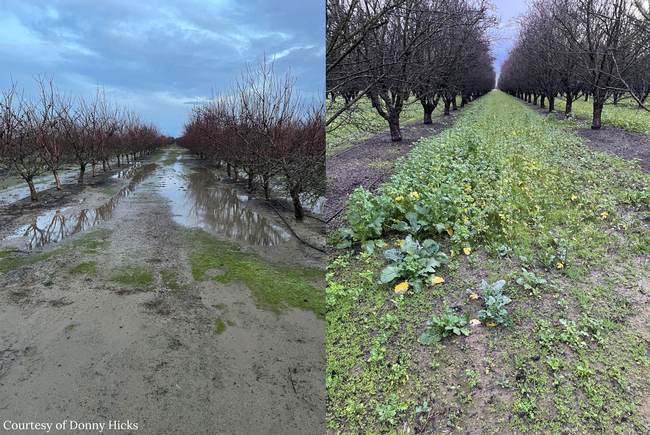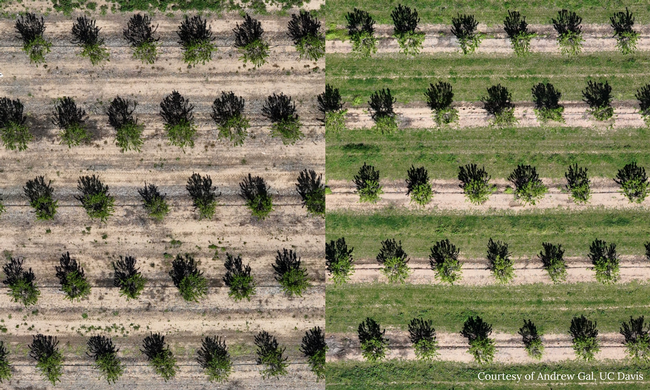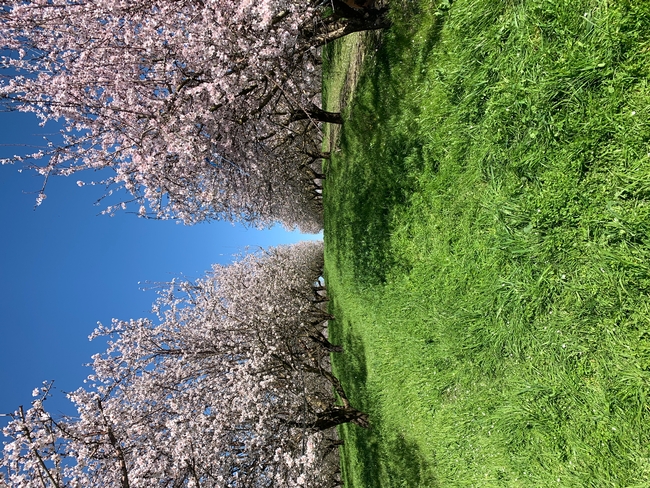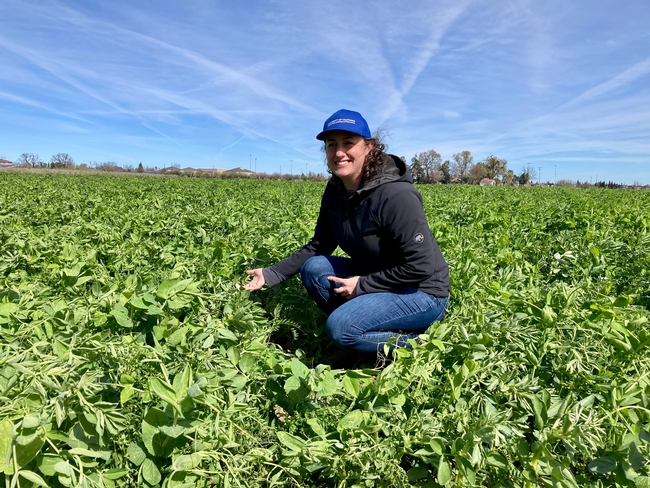Posts Tagged: cover crops
CASI's Mitchell on MyAgLife podcast, June 28, 2024
CASI's Mitchell on MyAgLife podcast June 28, 2024
July 1, 2024
Jeff Mitchell, CASI member and Professor and Cropping Systems Cooperative Extension Specialist in the Department of Plant Sciences at the University of California, Davis, appeared in a 39-minute podcast with host Taylor Chalstrom on June 28, 2024 to talk about conservation agriculture in general and the recently-published article in California Agriculture on the 20-year study in Five Points, CA. The podcast is available at
https://spotifyanchor-web.app.link/e/JuQ7qakGSKb
You may need the podcast platform, Spotify, to listen to it.

MyAgLife June 28, 2024 Image
Report: Cover crops benefits may outweigh water-use in California
Additional guidance needed for groundwater management strategies
Cover crops are planted to protect and improve the soil between annual crops such as tomatoes or between rows of tree and vine crops, but growers may be concerned about the water use of these plants that don't generate income.
“Cover crops are one of the most popular practices we see farmers employ through our Healthy Soils Program,” said Karen Ross, secretary of the California Department of Food and Agriculture. “Cover crops supply a host of benefits, such as helping to protect against soil erosion, improving soil health, crowding out weeds, controlling pests and diseases, and increasing biodiversity; and they can bring increased profitability as the number of other inputs are reduced. They also provide water benefits such as improved infiltration and reduced runoff.”
These potential benefits are especially salient in the San Joaquin Valley, where groundwater challenges are more acute. A new report evaluates the water implications of cover cropping practices to lay the groundwork for their adoption in the context of the Sustainable Groundwater Management Act, or SGMA, which is intended to protect groundwater resources over the long-term.
“Yes, cover crops require a nominal amount of water to establish – and sometimes rainwater is sufficient – but the myriad co-benefits are worth it,” Ross said.
Growers, water resource planners and managers, crop consultants, irrigation practitioners and policymakers may find the cover crops report useful.
The report is the product of a convening process jointly developed by the California Association of Resource Conservation Districts, CDFA, Natural Resources Conservation Service of California, and University of California Agriculture and Natural Resources, and assembled by nonprofit Sustainable Conservation.
The multidisciplinary group of more than 30 individuals has published “Cover Cropping in the SGMA Era.” The literature review, policy analysis and recommendations pertain to the water impacts of cover crop practices in California's Central Valley under SGMA.
Cover crops and their potential
“Wintertime rain-fed cover cropping does not necessarily significantly increase water losses compared to bare ground in the winter months,” said co-author Daniele Zaccaria, associate professor in agricultural water management for Cooperative Extension at UC Davis. “Cover cropping can significantly improve soil-water dynamics, increasing soil water infiltration and storage and reducing surface runoff.”
To reap the benefits of cover crops using minimal water, Zaccaria said growers will need to know how the plants perform under different conditions.
“We need to develop and implement a coordinated research effort to increase understanding of net water impacts of cover crops under various meteorological conditions – dry, wet, average," he said.
Report findings and recommendations
To understand the potential of cover cropping under SGMA, the report's authors came together to answer the following questions:
- What are the impacts of cover crops on water cycles (both benefits and use)?
- How does SGMA management account for cover cropping and is it capturing cover crop benefits alongside their water use?
- How can we ensure that this practice remains available to growers where and when it makes sense?
This report synthesizes the learnings from the collaborative initiative including 100-plus multidisciplinary experts, a policy analysis, interviews with Groundwater Sustainability Agency (GSA) staff and consultants, and the expertise contributed by its 30-plus authors. In light of these findings, the report advances a series of recommendations aimed at bridging critical knowledge gaps, enhancing the integration of cover crops into policies and incentive programs, and bolstering data infrastructure and other mechanisms to support sustainable groundwater management initiatives.
One vital throughline is the need for additional guidance from the state to support local GSAs in facing the complex challenges of developing and implementing groundwater management strategies for their local watersheds. These measures aim to optimize cover crop integration within SGMA frameworks and promote sustainable water management practices crucial for the region's agricultural resilience and environmental health.
“This report is unique because the university collaborated closely with state agencies and private sector partners to ensure that the different perspectives provided both the best science available as well as viable policy options,” said Glenda Humiston, University of California vice president for agriculture and natural resources. “By taking a comprehensive view, we can advance recommendations for cover crop policy that help us meet multiple goals, manage our natural resources more effectively, and avoid unintended consequences.”
Sarah Light, UC Cooperative Extension agronomy farm advisor, is one of the UC ANR experts who provided science-based information during the convening sessions and co-authored the white paper.
“Cover crops are a valuable soil health practice that can help ensure the resilience of California farms to climate extremes,” said Light. “As we balance the complexities of water and soil management, it is important to understand the role that cover crops play in an annual water budget so that they are not disincentivized in certain parts of the state. This paper can provide guidance to GSAs and policymakers who are charged with implementing SGMA in their regions.”
The report “Cover Cropping in the SGMA Era” can be downloaded for free at https://suscon.org/wp-content/uploads/2024/05/SC-Cover-Crop-SGMA-Report.pdf.
Related research links:
Long-term reduced tillage and winter cover crops can improve soil quality without depleting moisture https://escholarship.org/uc/item/1cr6w7dp
Impacts of winter cover cropping on soil moisture and evapotranspiration in California's specialty crop fields may be minimal during winter months https://californiaagriculture.org/article/108637
Water-related impacts of cover cropping in California https://www.youtube.com/watch?app=desktop&v=mTNLx6LzEt0
20-year summary of soil health research in Five Points, CA published in California Agriculture!
May 17, 2024
Findings from twenty years of soil health research in Five Points, CA have been published in the University of California's California Agriculture peer-reviewed journal's May 1, 2024 issue. https://doi.org/10.3733/001c.94714.
This work has been a large collaborative effort involving twenty-one UC and non-UC coauthors. It began in 1998 initially as an effort to evaluate the potential of reduced disturbance tillage systems to reduce dust emissions from annual cropping systems that are common in California's San Joaquin Valley. It long-term nature however, allowed it to become a unique site for also monitoring changes in soil properties and function under four experimental systems: conventional tillage with no cover crop, conventional tillage with cover crop, no-till with no cover crop, and no-till with cover crop. Crops rotated between tomato and cotton initially, but later during the study, the rotation was diversified to include melons, sorghum, and garbanzo beans.
The work involved the Soil Health Institute's Shannon Cappellazzi, who sampled at the site in 2019. That sampling event led to the site becoming part of a multiple-publication series of articles that reported on soil health impacts in 124 long-term study sites across North America.
https://soilhealthinstitute.org/news-events/a-minimum-suite-of-soil-health-indicators-for-north-american-agriculture/

Screenshot 2024-05-17 080919 Cal Ag
Fresno State MS student shares his research work on strip-tillage!
Robert Willmott not only recently wrapped up his MS thesis research at Fresno State, but he also works full-time as the Farm Manager for his college's student ag farm, is married, and has two small children as well! A full plate, to say the least. In addition to all this, he recently told his story at Fresno State in a 3-minute video that is now posted at You Tube https://www.youtube.com/watch?v=Uo6xZh5sGdA
Working in the Department of Plant Science in the Jordan College of Agricultural Sciences and Technology under his award-winning and Fellow in the American Society of Agronomy major professor, Anil Shrestha, Robert presented his thesis work in an exit seminar on May 14th on campus ahead of being awarded this MS and graduating later this month. His work consisted of a multiple-year study to evaluate the potential of using a roller crimper and strip-tillage for producing silage corn under center pivot irrigation, a new systems approach for San Joaquin Valley dairies that rely on winter and corn silage for animal feed materials. The several years of the study saw quite good success in terminating a variety of winter cover crop mixes using the roller crimper, strong weed suppression during the early corn season, and corn yields comparable to industry standards and the conventional control system that was part of the evaluation.
The work is now being prepared for submission to a scientific journal later this summer. A three-minute You Tube video summarizing Robert's work may be viewed at the link https://www.youtube.com/watch?v=Uo6xZh5sGdA
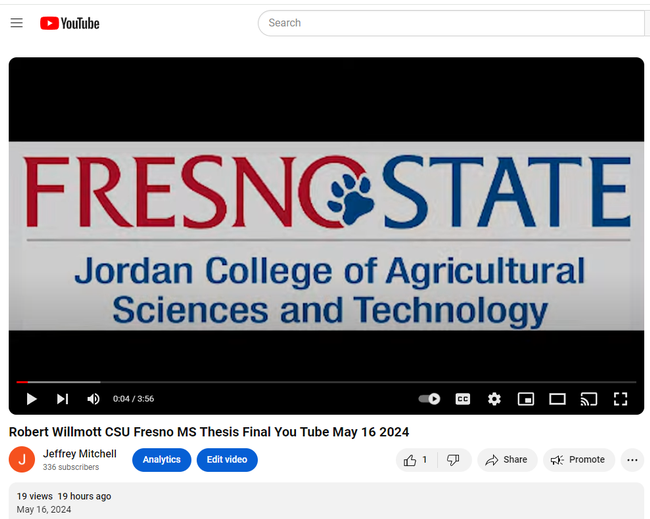
Screenshot 2024-05-17 074737 Fresno State
CASI hosts the Soil Health Institute's US Regenerative Ag Cotton Program leaders - April 11 and 12, 2024
April 12, 2024
The UC ANR CASI Center hosted five members of the Soil Health Institute's US Regenerative Ag Cotton Program in the San Joaquin Valley on April 11th and 12th, 2024. The Soil Health Institute (SHI) is a non-profit organization based in Morrisville, NC that conducts research and extension education related to soil health management. Five SHI members, Diana Bagnall, David Lamm, Jessica Kelton, Emily Ball, and Nate Looker, took part in the two-day tour of six San Joaquin Valley farms and the California Cotton Ginners and Growers Associations. San Joaquin Valley farmers who hosted the SHI members included Mark Borba of Borba Farms in Riverdale, CA, Mark McKean of McKean Farms also in Riverdale, Tony Azevedo of Stone Land Company in Stratford, CA, Cannon Michael and Derek Azevedo of Bowles Farming in Los Banos, Gary and Mari Martin of Pikalok Farms in Mendota, and Gary Smith of Ingleby Farms in Burrel. Roger Isom, President of the CCGGA in Fresno, also hosted the SHI guests.
SHI requested help from CASI with the cotton tour and discussions that took place as an effort to expand their national Regenerative Ag Cotton Program to California in 2024. The tour provided excellent opportunities for SHI to learn about California cotton and to make connections with leading cotton farmers in the San Joaquin Valley who may become part of the baseline soil sampling project that SHI is looking to conduct with cotton producers this year.
In addition to the farmers who generously hosted the SHI guests, several other local California folks including Cary Crum, Kimber Moreland, Rob Roy, Jacob Wright, and Olivia Peters helped CASI's Jeff Mitchell in sharing information about California cotton systems.
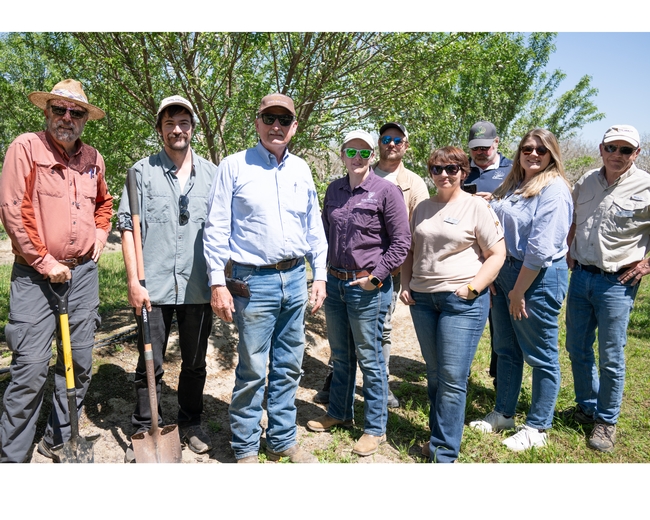
DSC0148-1 FINAL
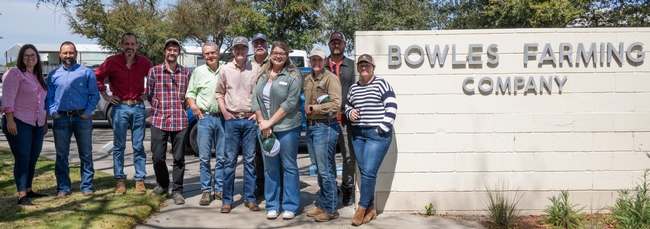
DSC0172-1 FINAL

